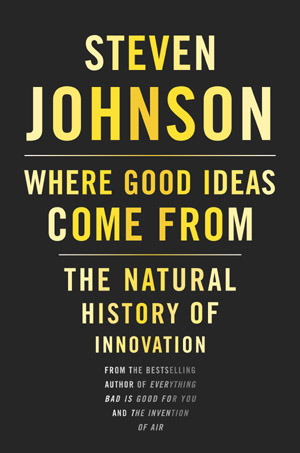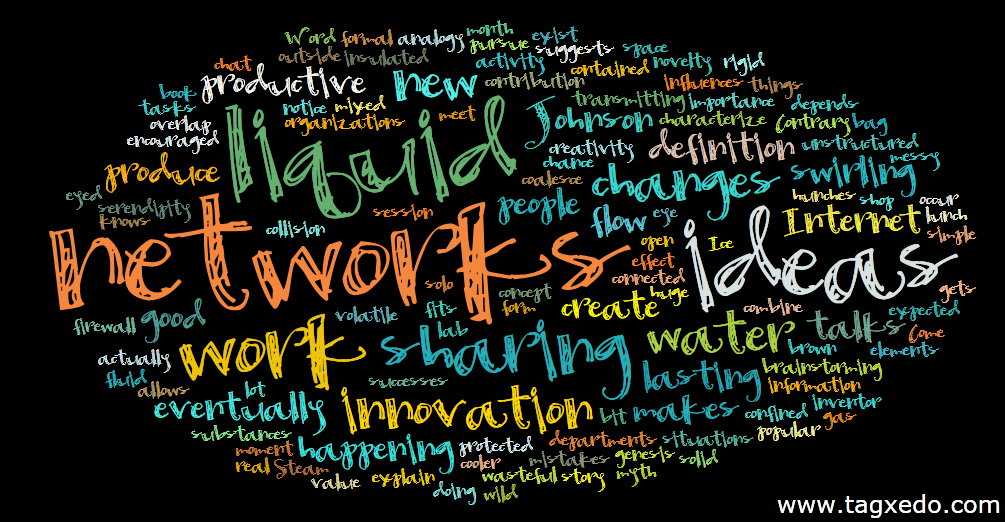


January 2011
In this Issue:
|
Say
It Quick |
Discoveries bits of serendipity to inspire and motivate |
Ideas fuel for your own continuous learning |
Activities tips and tricks you can try today |
| Wasting Work Time | Where Good Ideas Come From | Creating Innovative Flow | Your Next Brilliant Idea |
Great new ideas are all around us waiting to be discovered! If you are having trouble finding them, today's News Flash may be of help beginning with this 99-Word Story.
Wasting Work
Time
Listening to the radio, I heard that Americans waste an average of 2 hours
at work every day. That translates into $759 billion lost!
Me? I never waste time at work. I'm too busy making connections, building social capital. A walk to the water cooler puts me in touch with other people, their projects, their problems, and their needs. Even the physical act of moving gets my brain working in different ways, exploring new paths. I always return to my desk with several new ideas.
Perhaps we ought to redefine "work" and how we value it!
 Where
Good Ideas Come From: The Natural History of Innovation
Where
Good Ideas Come From: The Natural History of Innovation
by Steven Johnson
"How did they ever think of that?"
This was a phrase I often heard from my mother. It expressed her awe about brilliant innovations whenever she saw them. It also expresses the common perception that new ideas come to us out of thin air.
In his book Where Good Ideas Come From, Steven Johnson dispels this myth by offering a historical perspective on how new ideas are conceived, evolve, and take root in society. Instead of brilliant ideas coming to us out of the ether, Johnson explains that each innovation is build upon previous ideas. New concepts are always cobbled together. Each idea actually uses previous innovations as its building blocks. And some ideas are even ahead of their time because there isn't the political, social, or physical infrastructure in place to support them. The earliest programmable computer was conceived and designed by Charles Babbage in the 1870's but it couldn't actually be built out of the mechanical gears available at the time. The idea had to wait until the vacuum tube was invented nearly 100 years later!
Johnson uses much of his book to describe the type of environment most conducive to innovation. He backs that description up with extensive historical examples. An innovation-ripe environment…
Johnson also challenges the common notion that the competitive marketplace is the best environment for new ideas. Because competition typically has to do with developing ideas that are marketable, a market-driven innovation may be shrouded in secrecy by patents and copyrights. While these laws do protect the intellectual property of the inventor, they set up barriers that prevent further innovation by limiting the free exchange of ideas that can produce synergy. Profit is sometimes a motivation for innovation, says Johnson, but it is not the biggest source of new ideas. A university research environment is typically more conducive to paradigm-shifting innovations.
The book includes an informative Chronology of Key Innovations, 1400 - 2000 which provides helpful perspective for people who, like my mother, are dazzled by innovation.
Whether you want to shift a paradigm or energize your own creative process, you'll find ideas, inspiration, and historical examples in Where Good Ideas Come From, © 2010 Steven Johnson, Riverhead Books, ISBN 978-1-59448-771-2.
 Creating
Innovative Flow
Creating
Innovative Flow
The 99-Word story this month suggests that whether what we are doing at work
is wasteful or productive depends upon our definition of what work is. There
is a lot that could be happening around the expected work tasks that
actually makes a huge contribution to the real work that eventually
gets done.
The same could be said for creativity: it's not an activity that fits a simple definition. Contrary to the popular myth of the wild-eyed inventor working solo in a lab, good ideas that characterize lasting innovations occur most often in situations where many ideas are shared, people are encouraged to pursue hunches that produce mistakes as well as successes, and there is space for serendipity.
One concept that Johnson talks about in his book Where Good Ideas Come From, is the importance of liquid networks. Anyone connected to the Internet knows the value of networks for transmitting and sharing information. But a network protected by a firewall is also insulated from the outside influences that could be the genesis of a new idea. A fluid network that allows for the overlap and collision of ideas is more likely to produce novelty.
Johnson makes the analogy of water changing from a solid to a gas to explain liquid networks. Ice is too rigid for any change to happen. Steam is too volatile for any changes to be contained and have a lasting effect. However, water in its liquid form can combine with many other elements to create new substances. In a liquid network, things are a bit messy and mixed up as ideas swirl around but in that swirling, something new will eventually coalesce.
Liquid networks are not confined to the Internet. They exist in organizations when people meet across departments to talk shop. Whether it's a brown bag lunch or chance moment of chat at the water cooler, unstructured sharing can be as productive as a formal brainstorming session.
Keep an eye open for liquid networks in your work environment and when you notice the flow of innovation, please !
Your Next
Brilliant Idea
What will be the spark of your next creative idea? When will it happen? Is
there a concept you've been wondering about for a while, a "slow hunch" as
Johnson would call it, that's waiting to be connected to other concepts before
it can take off as an innovation?
You don't need to be at the whim of chance. Get your creativity flowing by fostering your own liquid network for innovation. Here are a few suggestions:
Try any of these suggestions then take one more step: get physical. Go for a walk, take a shower, shovel snow, work in the garden, vacuum the bedroom. Any physical activity will allow your mind to free associate, flowing from one idea to another making links and connections you hadn't expected.
When you invent new connections or ideas after this activity, . I'll be surprised if you don't discover something!
Read previous
issues. Click Archives!
To add or delete your name to our mailing list, email
with a short note in the subject line.
I want this newsletter to be practical, succinct, and thoughtful. If you have suggestions about how we can meet these criteria, please let us know! Send us an with your thoughts and ideas.
Home
| Services
| Products
| Mission
| Ideas |
The Group
| The Buzz
(c)
2005 - 2010 The Firefly Group